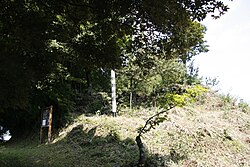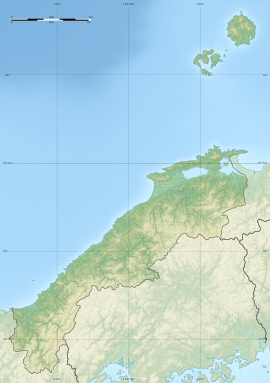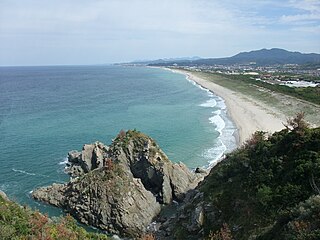
Shimane Prefecture is a prefecture of Japan located in the Chūgoku region of Honshu. Shimane Prefecture is the second-least populous prefecture of Japan at 665,205 and has a geographic area of 6,708.26 km2. Shimane Prefecture borders Yamaguchi Prefecture to the southwest, Hiroshima Prefecture to the south, and Tottori Prefecture to the east.
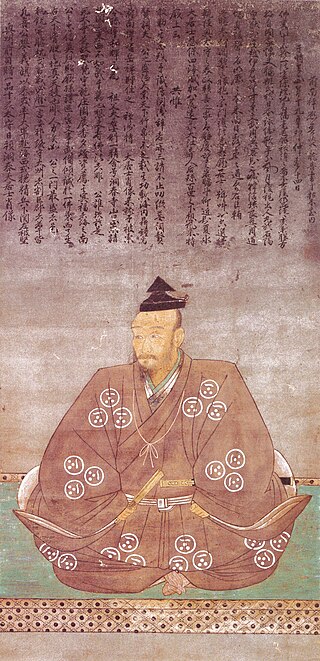
Mōri Motonari was a prominent daimyō in the western Chūgoku region of Japan during the Sengoku period of the 16th century. The Mōri clan claimed descent from Ōe no Hiromoto (大江広元), an adviser to Minamoto no Yoritomo. Motonari was called the "Beggar Prince". He was known as a great strategist who began as a small local warlord (jizamurai) of Aki Province and extended his clan's power to nearly all of the Chūgoku region through war, marriage, adoption and assassination.

Amago Haruhisa was a daimyō warlord in the Izumo Province, Chūgoku region of western Japan. He was the second son of Amago Masahisa. Initially named Akihisa (詮久), he changed his name to Haruhisa in 1541 after Ashikaga Yoshiharu offered to let him use a kanji character from his name.

Amago Katsuhisa was a remnant of the Amago clan, a powerful feudal clan in the Chūgoku region of Japan, backed up by Yamanaka Yukimori, a vassal of the clan.

Amago Tsunehisa was a powerful warlord who gained the hegemony in Chūgoku region, Japan starting as a vassal of the Rokkaku clan. He ruled the domains of Inaba, Hōki, Izumo, Iwami, Oki, Harima, Mimasaka, Bizen, Bitchū, Bingo, and Aki.
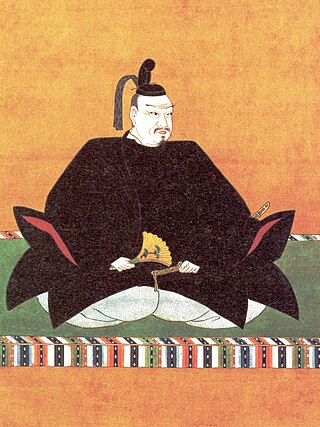
Mōri Terumoto was a Japanese daimyō. The son of Mōri Takamoto, and grandson and successor of the great warlord Mōri Motonari, he fought against Oda Nobunaga but was eventually overcome. He participated in Toyotomi Hideyoshi's Korean Campaign (1592) and built Hiroshima Castle, thus essentially founding Hiroshima.

Iwami Province was an old province of Japan in the area that is today the western part of Shimane Prefecture. It was sometimes called Sekishū (石州). Iwami bordered Aki, Bingo, Izumo, Nagato, and Suō provinces.

Tottori Castle was a Japanese castle located in Tottori, Tottori Prefecture in the San'in Region of western Japan. It has been protected by the central government as a National Historic Site since 1957 with the area under protection expanded in 1987. The Historical Site designation also includes the Taikōganaru (太閤ヶ平) fortification erected by Toyotomi Hideyoshi during the 1581 Siege of Tottori.

Kikkawa Motoharu was the second son of Mōri Motonari, and featured prominently in all the wars of the Mōri clan. He became an active commander of the Mōri army and he with his brother Kobayakawa Takakage became known as the “Mōri Ryōsen", or “Mōri's Two Rivers" (毛利両川).

Ōuchi Yoshioki became a sengoku daimyō of Suō Province and served as the 15th head of the Ōuchi clan. Yoshioki was born early in the Sengoku period, the son of Ōuchi Masahiro, shugo of Suō Province and the 14th head of the Ōuchi clan. The first character in Yoshioki's name originated from Ashikaga Yoshihisa, the ninth shōgun in the Muromachi bakufu. In 1492, Masahiro ordered Yoshioki to join the battle against Rokkaku Takayori, a sengoku daimyō from southern Ōmi Province. In the midst of this engagement in 1493, an incident known as the Meiō no seihen occurred, by which Hosokawa Masamoto, a kanrei, or deputy, held the shōgun, Ashikaga Yoshiki, in confinement. Yoshioki withdrew his men from the battle to Hyōgo in Settsu Province to wait for the outcome of the event, which resulted in Yoshiki being deposed and replaced by Ashikaga Yoshizumi. Yoshioki's younger sister was abducted while staying in Kyōto in an area under the control of Takeda Motonobu, an ally of Hosokawa Masamoto. Masamoto took her hostage as leverage against Masahiro in his support for Yoshiki. Masahiro then ordered close associates of Yoshioki to commit seppuku. This may have been as retribution for what he viewed as Yoshioki's tepid response to the pressure exerted upon him by Masamoto and his retainers. Nevertheless, Yoshioki's decision to withdraw his forces was well-received by the hikan, or administrators, in his birthplace of Kyōto, building relationships that benefit him later at the time of his succession to Masahiro.

Kobayakawa Takakage was a samurai and daimyō during the Sengoku period and Azuchi–Momoyama period. He was the third son of Mōri Motonari who was adopted by the Kobayakawa clan and became its 14th clan head. He merged the two branches of the Kobayakawa, the Takehara-Kobayakawa clan (竹原小早川氏) and Numata-Kobayakawa clan (沼田小早川氏). He became an active commander of the Mōri army and he with his brother Kikkawa Motoharu became known as the “Mōri Ryōsen", or “Mōri's Two Rivers" (毛利両川). As head of the Kobayakawa clan, he expanded the clan's territory in the Chūgoku region, and fought for the Mōri clan in all their campaigns

Mōri Takamoto was a daimyō of Aki Province during Japan's Sengoku period. He was the eldest legitimate son of Mōri Motonari.

Gassantoda Castle was a Sengoku period yamajiro-style Japanese castle located in Izumo Province, in what is now part of the city of Yasugi, Shimane Prefecture in the San'in region of far western Japan. Its ruins have been protected by the central government as a National Historic Site since 1934. Gassantoda Castle was built using whole of Mount Gassan's ridges and valleys, and is regarded as one of the five largest and most important medieval mountain castle along with Kasugayama Castle (Niigata), Nanao Castle (Ishikawa), Odani Castle and Kannonji Castle (Shiga).

Hagi Castle was a Japanese castle located in the city of Hagi, Yamaguchi Prefecture, in the San'yō region of Japan. Built in 1604 at the beginning of the Edo period as the main castle of the Mōri clan, it served as the seat of the Chōshū Domain for over 250 years until 1863. It was demolished in 1874 shortly after the Meiji Restoration. Its ruins were designated a National Historic Site in 1924. Hagi Castle has been designed as a component of the Sites of Japan's Meiji Industrial Revolution: Iron and Steel, Shipbuilding and Coal Mining, which received UNESCO World Heritage Site status in 2015.

Mihara Castle was a hirajiro-style Japanese castle located in what is today the city of Mihara in Hiroshima Prefecture. Its ruins have been protected by the central government as a National Historic Site since 1957.
The Masudaclan was a Japanese clan in the Iwami Province, Japan, from the 13th century until 1600.

Tsuwano Castle was a Japanese castle located in what is now the city of Tsuwano, Shimane Prefecture, in the San'in region of far western Japan. Its ruins have been protected by the central government as a National Historic Site since 1942. In its early history, it was called Sanbonmatsu Castle or Ipponmatsu Castle. During the Edo Period, it was the center of Tsuwano Domain ruled by the Kamei clan; however, the administrative offices and daimyō residence were located at the base of the mountain to avoid the steep mountain paths.

Yoshida-Kōriyama Castle was a Japanese castle located in Akitakata, Hiroshima Prefecture. It was also called Aki-Kōriyama Castle from its location in former Aki Province. Its ruins have been protected by the central government as a National Historic Site since 1940.

Niitakayama Castle of Aki Province was a yamajiro-style Japanese castle located in what is today the Hongō neighborhood of the city of Mihara in Hiroshima Prefecture. Its ruins have been protected by the central government as a National Historic Site since 1957.

Miyake-Odoi Site is an archaeological site with the traces of a Muromachi period fortified residence, located in what is now the Miyake neighborhood of the city of Masuda, Shimane Prefecture, in the San'in region of western Japan. Its ruins been protected by the central government as a National Historic Site since 2004 together with the Nanao Castle ruins as the "Masuda clan fortification ruins".
